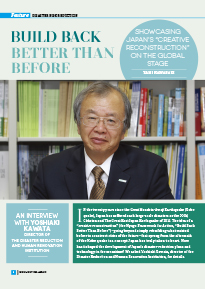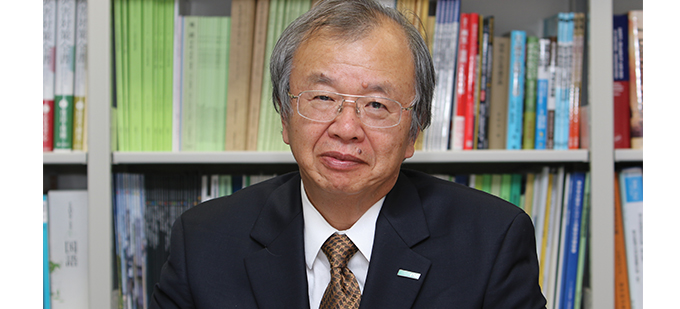Home > Highlighting JAPAN >Highlighting Japan March 2015>Disaster Risk Reduction
Highlighting JAPAN

Build Back Better Than Before
an Interview with Yoshiaki Kawata
director of the Disaster Reduction and Human Renovation Institution

In the twenty years since the Great Hanshin-Awaji Earthquake (Kobe quake), Japan has suffered such large-scale disasters as the 2004 Chūetsu and The Great East Japan Earthquake of 2011. The idea of a “creative reconstruction” (the Hyogo Framework for Action, “Build Back Better Than Before”)—going beyond simply rebuilding what existed before to construct cities of the future—that sprang from the aftermath of the Kobe quake is a concept Japan has truly taken to heart. How has it shaped the development of Japan’s disaster-reduction plans and technology in the meantime? We asked Yoshiaki Kawata, director of the Disaster Reduction and Human Renovation Institution, for details.
![]()
Please tell us about the current state of Japan’s disaster reduction technology and strategies.
“Disaster prevention” is more properly called “disaster reduction”—it means foreseeing disasters, providing prompt notification, and taking countermeasures to keep the human and economic costs as low as possible. Disaster reduction technology in Japan is advancing day by day; our disaster reduction system could be called the world’s best. Thanks to the efforts of our top-notch scientists, our disaster predictions and damage estimates are steadily becoming more precise, and the systems we use to communicate that data to the public capitalize on advanced technology for better accuracy and speed.
However, no matter how advanced our technology is, if those coping with the situation can’t use the technology and systems well when disaster strikes, the system is useless. It’s supremely important for people to always be disaster-conscious, that we remain aware of and familiar with our advanced disaster reduction systems, and that long-term relationships are forged in the community.
As a specialist in the field of disaster reduction, that lesson hit home for me after the Kobe quake. In those days, I was developing disaster reduction technology such as tsunami numerical simulations and retrofitting lifeline systems as a professor at Kyoto University, but even though my technology was installed in the disaster area, it was simply left unused.
In the two decades since the Kobe quake, disaster reduction technology has advanced, and there has been a push to involve the public and the larger culture in disaster reduction so they’re able to properly use the technology. Policywise, Japan is the only nation that has opened up and increased transparency of the process of developing our disaster reduction plans, with the Cabinet Office’s Central Disaster Prevention Council and elsewhere. This raises disaster reduction awareness and helps ensure that the memory of past disasters won’t fade away.
What sorts of guidelines need to be established for disaster reduction in Japan?
Disaster reduction plans put in place to ensure that locations struck by disaster once aren’t damaged again don’t apply to disasters of unprecedented scope that occur in areas that haven’t been hit yet. We need legislation to ensure that Japan’s sophisticated prediction technology is used to create accurate damage forecasts, that plans are enacted, and that decisions are made quickly and instructions issued rapidly when catastrophe strikes. Before the next calamity occurs, we should concentrate on transitioning quickly from our current mindset—focusing on coping with the aftermath—to a proactive society that emphasizes prediction and reduction.
What disaster reduction expertise can Japan share with the world?
As a major force in disaster reduction, Japan cannot be content to merely promote the strength of our technology to the world; we need to share our experiences and the details of our public initiatives. The advantages of a disaster reduction system that involves all of society—as well as the difficulties inherent in adopting it—must be communicated to the world. For example, during the Great East Japan Earthquake, the tsunami breakwaters along the Sanriku coast were the highest and most extensive in the world at that time, and yet there were people who died because they knew that and felt safe. Even with the 2014 landslide disasters in Hiroshima due to heavy rains, which happen in the Hiroshima area every five or six decades due to geological reasons, the memory of the disaster fades, and so no preventive measures were taken against future damage. There’s no magic bullet when it comes to disaster reduction, but if disaster reduction awareness takes root in the society and culture, more people will be saved. Even in Japan, which possesses the world’s most advanced disaster reduction technology, we face so many challenges, but I believe our struggles in this area will prove very instructive to other countries.
© 2009 Cabinet Office, Government of Japan






